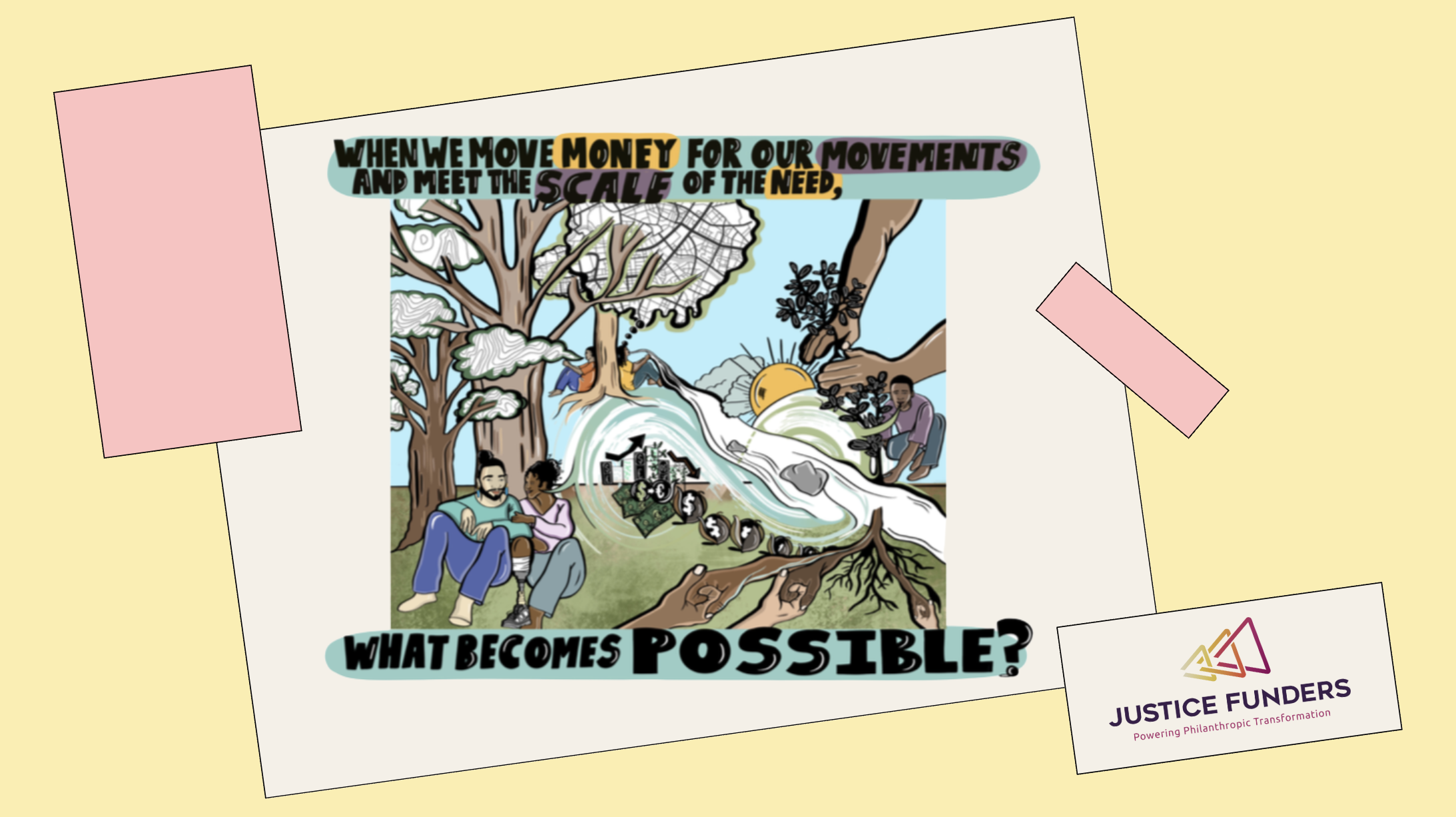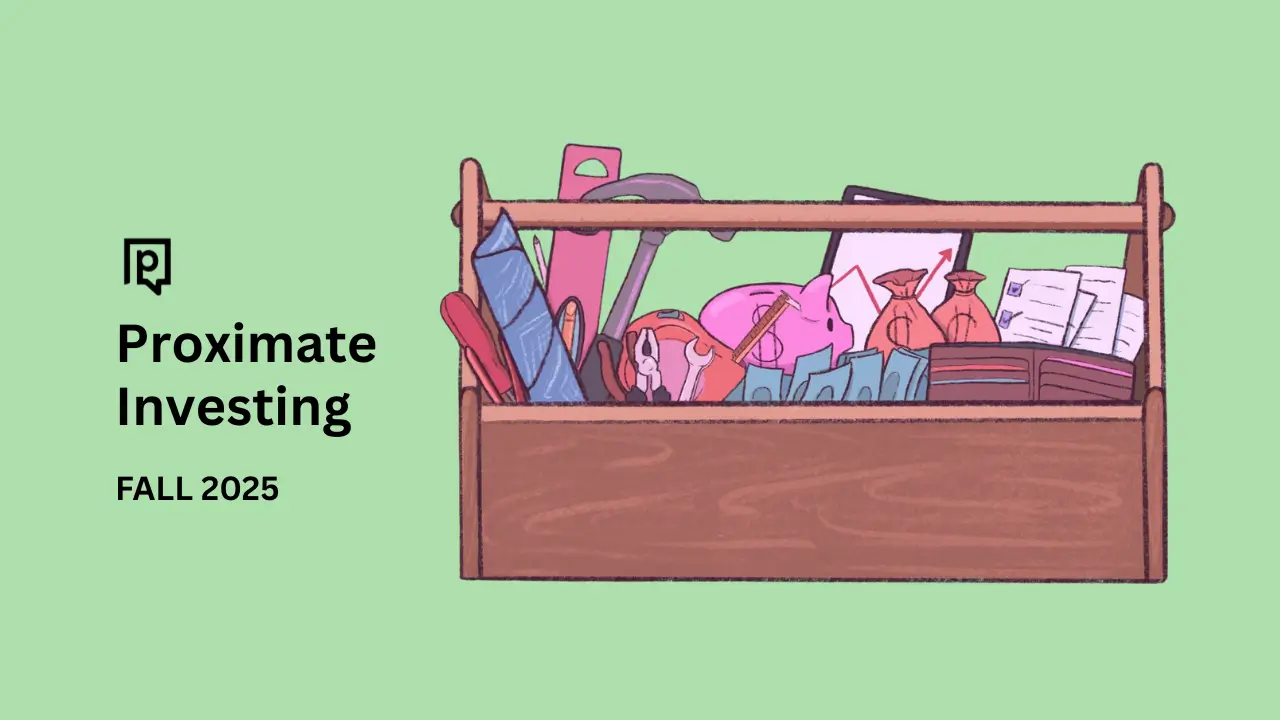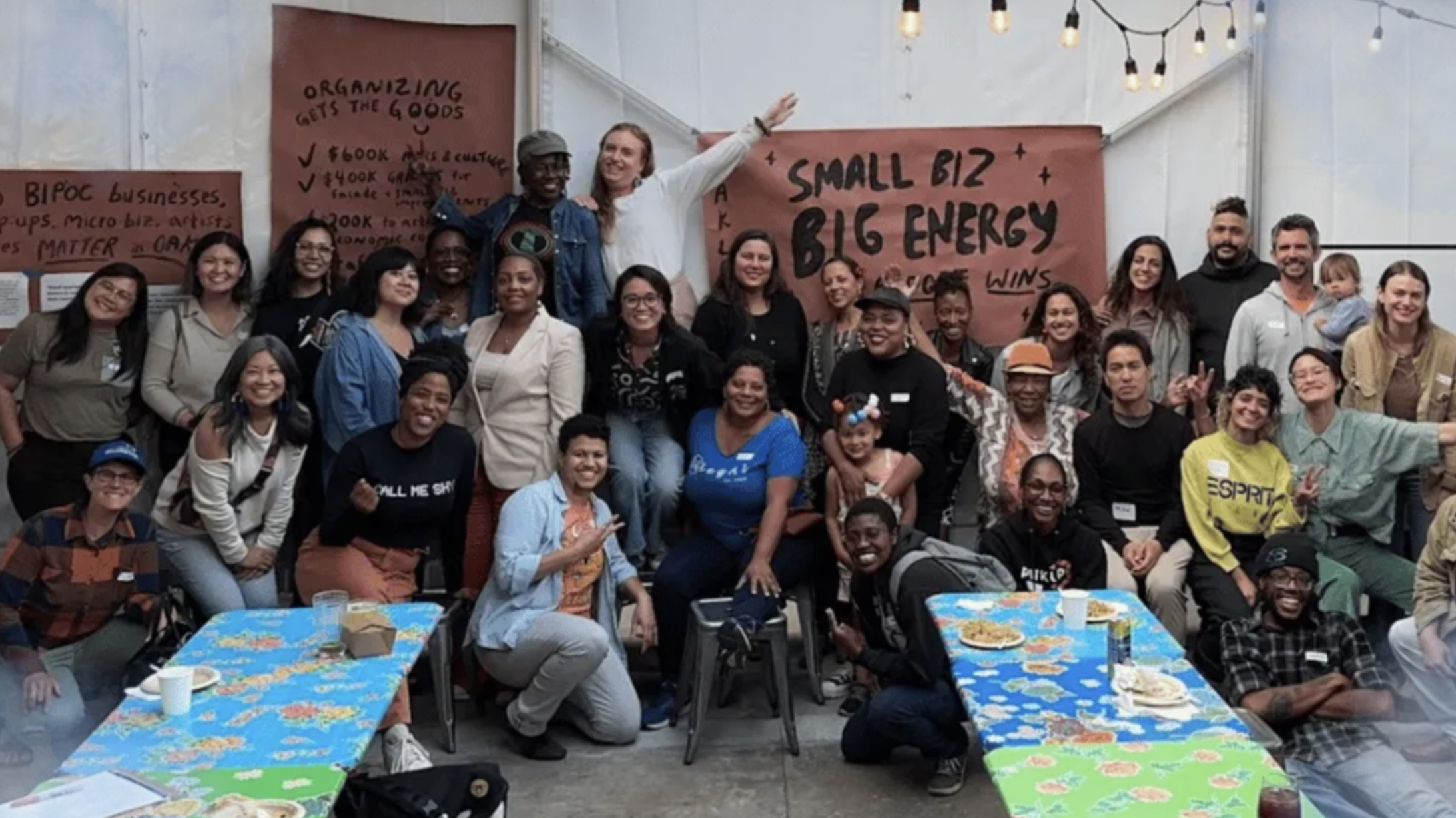Some people think that a 0% loan is the same as a grant.
That’s one of the misconceptions that Lora Smith has found herself fighting as Director of Investment Partnerships at Justice Funders. In 2023, the organization launched the Just Transition Integrated Capital (JTIC) Fund, a “movement-controlled, democratically governed” investment and learning vehicle designed to help foundations shift their assets off Wall Street and into non-extractive investments that support regenerative economies.
With its commitment to 0% interest financial returns for investors, the JTIC Fund is trying to mainstream a borrower-first approach to supporting community-controlled projects and investment funds that build the economic power and self-determination of frontline BIPOC and working-class communities. These investments are already providing valuable learnings to a growing chorus of philanthropic leaders who are questioning endless wealth accumulation and looking to extend participatory movement governance to their endowment’s investments.
In its first two years, the JTIC Fund has completed two rounds of investments and deployed $5 million: $4.5 million in 0% interest loans to Right to the City Alliance’s Integrated Capital Loan Fund and East Bay Permanent Real Estate Cooperative, and $500,000 in grants to community-led funds. This Spring, they also released a tool lending library as an open resource for funders and investors who want to learn from and adapt the JTIC Fund’s practices.
In this conversation, Justice Funders’ Lora speaks to the conventional financial logic that protects capital over communities and keeps philanthropic dollars trapped in extractive financial systems. She also shares how the JTIC Fund is forging new approaches to due diligence and capital deployment that prioritize capacity-building, interdependence, and borrowers’ holistic wellbeing.
More and more, foundations are embracing the idea of aligning their endowment investments with their mission, values, and goals. What barriers are foundations facing when trying to take that next step?
It's important to understand that the current economic system and the philanthropic sector are designed to protect wealth. Traditional lending practices place risk on the borrower—often the community—while shielding the wealth holder. Fund managers and investment committees are trained to see protecting wealth and maximizing profit as their top priority.
This view informs their risk assessment and management practices and due diligence processes, which have become huge barriers for community-led projects and funds. Traditional risk analysis can make community-led projects and funds look very risky on paper, even when they’re not.
We’ve seen 0% investments, regardless of investment size, questioned and labeled as “jeopardizing” by lawyers and CPAs, even when they’re designed simply to preserve capital. We're pushing back against these deeply entrenched mindsets to reframe how risk is understood and who we’re trying to protect in the transaction. There’s certainly a lot of muscle memory and unlearning to do.
What have you learned from the JTIC Fund's first fundraising period?
We’ve raised around $6.8 million to date, and the capital call is still open.
A common misconception we run into is people thinking 0% investments are grants. They’re not—they’re a capital preservation strategy. You get your money back. But people often assume it’s equivalent to a grant and then either want to include it in their grant portfolio or aren’t sure how to categorize it.
We will accept grants, but our ultimate goal is to push foundations to consider what percentage of their portfolio they could transition into non-extractive capital—through 0% loans or 1-3% below-market investments.
It’s a hard moment to fundraise in general right now. We’re battling a tide of foundations recoiling out of fear, clawing back their assets to protect their wealth.
What do you look for in potential investors?
We have a checklist for relational alignment and readiness that grew out of the Just Transition Investing Framework. Before approaching us, we ask foundations to have already had the internal conversations to prepare them for a 0% investment. That includes questioning the origins of their wealth, acknowledging the communities it was taken from, being critical of perpetual growth and wealth accumulation, and pursuing deeper relationships with communities.
Being a 0% interest fund naturally screens many people out. That said, we still get asked, “Would you consider 1% or 2%?”
And we hold firm to saying no. We’re not going to make exceptions or negotiate individual terms. For the most part, the foundations or individuals who are drawn to this opportunity have already done the deep internal work and are ready to commit to 0%.
What did you learn as the JTIC Fund went through its first due diligence processes?
Our first due diligence process was with Right to the City, an incredible group with an integrated capital fund connected to their grassroots housing organizing across the U.S. Because of the trust we’d built, they felt able to be very honest about how the process brought up a lot of negative experiences they’ve had with lenders and funders previously.
We learned we hadn’t created a safe or supportive enough process—despite our intentions, we ended up replicating dynamics that have been traumatic for many, especially Black people, Indigenous people, people of color, and working-class people. It was a hard moment, but a transformative one.
We ended up throwing out the traditional "due diligence" model and co-creating what we now call our relationship and capacity-building process. One of the main shifts was centering the borrower’s financial, psychological, and emotional well-being—not just our needs as a lender.
Our second loan with East Bay Permanent Real Estate Cooperative confirmed it was working. They had positive feedback and reported that the process, including our investment in technical assistance, added capacity and new knowledge.
Right now, we have three more funds in the waterway. Those are Moonsoon Fund, Equitable Food-Oriented Development (EFOD), and Climate Justice Alliance.
Tell me about the “Contract of Interdependence” the JTIC Fund adopted. How does that differ from conventional conflict of interest policies?
Usually, conflict of interest policies advance this false notion that conflicts of interest can be entirely eliminated. There are so many double standards and inconsistencies in how they’re applied, especially within white-led financial institutions. I’ve seen foundations with trustees who also own the wealth management firm overseeing the foundation’s endowment. That’s a clear conflict—it's in that trustee's interest to keep growing the endowment, and that dynamic, in part, prevents the institution from questioning whether untethered wealth accumulation serves its mission. But when a community member sits on a board and is also a grantee, it's suddenly flagged as a problem.
Rather than labeling some conflicts as acceptable and others not, our governing committee wanted to be upfront about our interdependence. That’s how we came to adopt our Contract of Interdependence.
Given the emphasis on relationality throughout the JTIC Fund’s approach to investing, how has the Governing Body prepared to navigate other kinds of conflict?
We were really intentional from the start about creating a conflict resolution policy, and it’s actually written into our loan agreements.
That policy involves a process that centers the borrower’s financial and psychological well-being. It’s reflected directly in the loan agreement documents, which reference and uphold that policy.
Being in right relationship includes anticipating the possibility of conflict and proactively thinking about how we want to move through it together to reach a transformative outcome, instead of punitive ones.
Are there any existing underwriting practices or tools that you think are still useful and could be repurposed towards more just investing?
There are definitely aspects that are useful—if approached with curiosity and collaboration.
The biggest issue with traditional due diligence processes is they are incredibly burdensome to prospective borrowers. Often, there's a lot of documentation being collected that isn’t legally or financially necessary. Instead, we should ask: what’s actually needed to assess the health of a fund or project, and what can we learn from those documents together? If a borrower doesn’t already have something like a five-year pro forma, can we provide technical assistance to support them in developing those? How can our processes build the capacity of emerging funds and community-led projects to access more capital from other investors later? That ultimately helps your investment be more successful.
We should approach this process as partners, not from a place of judgment or trying to dig for deficits or weaknesses. Instead, we’re trying to center the borrower and be in right relationship with them. Let’s be in community together, learn from one another, and see where there might be room for growth that we could help with. We're in this investment together and want to make it as successful as possible.
What can we learn from how the JTIC Fund is iterating its approach to impact measurement and reporting?
The JTIC Fund is meant to be a learning tool for philanthropy. So it felt like a missed opportunity to only do traditional impact reporting focused on the borrower. We trust and believe that community is doing what it’s supposed to do. We collect data on our investments to learn alongside our investees and borrowers.
But we also want to learn what our investors are learning in this process. For many of them, this might be their first 0% investment. We want to understand what internal barriers, structures, or policies had to change for this to happen? That’s why we’re also doing reporting on the investor side, so we can share out that learning as a return with the broader field of philanthropy.
One could say there’s an obsession with impact measurement that’s tied to this fixation on rigor and the fear that capital isn’t being deployed strategically. What role do you think rigor should play, and where does that responsibility lie?
I think you’re exactly right in that analysis. So much scrutiny is placed on impact investments or grantees, but that scrutiny isn’t applied to the rest of the portfolio in the same way. Often, they can’t even tell you where parts of their portfolio are invested—even though those investments usually make up the majority of a foundation’s assets under management.
Our partners and investors at the #NoRegrets Initiative have taught us about this concept of building a “beautiful portfolio.” Instead of focusing on intensive, data-driven analysis of impact, they measure the quality of the relationships in their portfolio. Of course, that can be challenging too—it’s qualitative, and power dynamics still exist between investors and investees—but they prioritize how the relationship feels between the investor and investee, and between the investees and the ecosystem that they've been creating.
There’s a lot to learn from shifting beyond the purely analytical ‘headspace’ of data and into the embodied, somatic knowing we feel when we’re making good investments that create real impact.
The JTIC Fund is expected to sunset in 2034, ten years after the initial deployment. How is the JTIC Fund approaching its capital deployment strategy to support its investees’ long-term well-being?
That’s an active conversation among the Governing Body. We work in different configurations: there’s the primary Governing Body, and then we have ad hoc committees or “circles.” One of those is our “Future of the Fund” circle, and they’re exploring this question now.
We originally saw this as a demonstration project. But we’re finding a real interest in the JTIC Fund becoming an evergreen fund. There’s a huge need and demand for 0%, non-extractive finance, especially for newer, younger funds and grassroots-led projects that need this kind of capital to build out their models and get introduced to other investors.
The Governing Body may decide that this fund will sunset, but then there will be a JTIC Fund 2.0 that launches as an evergreen fund.
So we’re almost seeing this fund as potentially a seed fund—one that can build the regenerative economy of many, many funds and community-controlled projects across the U.S. that we need if we want to create waterways and investment alternatives for foundations outside of Wall Street.
What are the kinds of questions the governing committee is grappling with—things you haven’t quite figured out yet, but that you’re excited or challenged by going forward?
As for what we’re still trying to figure out—it always comes back to messaging. How do we message to foundations and investors the importance of and need for these types of capital strategies—especially 0% or low-return investments in community-controlled funds?
What narrative strategies can help foundations and investors realize why these regenerative, community-stewarded financial systems are so necessary? That's the ongoing challenge: figuring out the right language and strategies to shift mindsets.
Has anything surprised you throughout this process? Or has anything been easier—or harder—than expected?
It wasn’t necessarily surprising, but a big lesson for us has been just how much time it takes to build something like this—because it’s so relationship-based. You need a lot of time.
When we launched the JTIC Fund in 2023, we started with the Just Transition Investing Framework as our foundation. But we were a group where some folks knew each other, and others didn’t. We had to come together to write an investment policy statement and really start imagining and dreaming together what this could be. It took a long time to build trust and strong relationships, but that’s what allowed us to eventually move more quickly. We’ve now developed a really tight-knit community, and that’s something I’m proud of—but it didn’t happen overnight.
So whenever I talk to groups that are starting their own community-controlled funds, I always say: Budget in a lot of time—double the time—you think you’ll need. Because you just can’t shortcut the relationship part. If you’re really building community, that takes time—and intention.







%20(1280%20x%20720%20px)%20(46).png)


.webp)
%20(1280%20x%20720%20px)%20(3).webp)


%20(1280%20x%20720%20px)%20(39).png)
%20(1280%20x%20720%20px).webp)

%20(1280%20x%20720%20px)%20(2).webp)



%20(1280%20x%20720%20px)%20(40).png)


.webp)
.webp)

